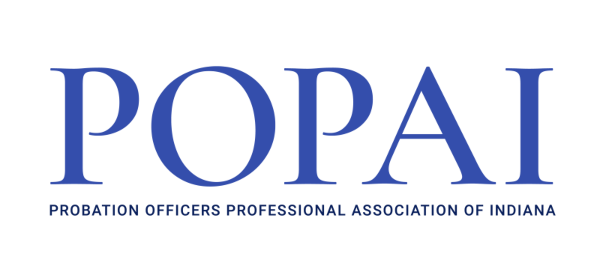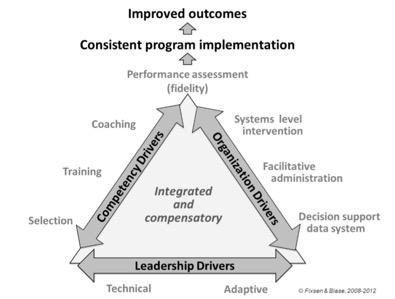The purpose of this article is to review systems-level factors that impact implementation of evidence-based practices (EBPs) in corrections which are often less understood in the research. I provide a brief overview of the National Implementation Research Network’s (NIRN’s) core implementation components I use as my framework for this discussion, and then go through two examples of systems-level impacts on correctional organizations. The last several years of my work have been dedicated to understanding how correctional programs and practices can feasibly implement in the “real-world,” both in my research, my experience working with community correction agencies, and government work. Community corrections agencies have seen very short-lived implementation of EBPs (Blasko, Viglione, Toronjo, & Taxman, 2019). I define EBPs using a combination of resources, specifically, Jerry Ratcliffe’s evidence hierarchy in his book Reducing Crime and the evidence continuum on crimesolutions.gov (when discussing the topic more generally). For the most part, agencies and individuals will indicate they “are already using or ‘doing’ EBPs” or they’ve already been “trained on that;” however, there is documented evidence that suggests actual implementation and sustainable use of EBPs as training occurs less frequently. While a variety of reasons may explain why this is so, there is less frequent discussion as to how systems-level factors may impact individual and organizational factors that support or hinder implementation and sustainability of EBPs.
While funders, administrators, and political figures and appointees are mostly concerned about offender outcomes, costs, and liability, the key to improving these outcomes and the efficiency and efficacy of EBPs lies not within the number of trainings provided to staff or individuals hired, but with regard to how, realistically, these training(s) and skills are then implemented and integrated into the organization to produce desired outcomes. While this is highly impacted by individual and organizational factors, systems-level factors likely have a vaster impact on the ability of individuals, organizations, and systems to shift strategies and fully support implementation and sustainability of EBPs. Research indicates the full shift is likely not occurring. In their study of all 38 Community Corrections Act (CCA) programs funded in Ohio, Lowenkamp and colleagues (2006) found 68% of programs were deemed “unsatisfactory” by the Correctional Program Assessment Inventory (CPAI), with 73% of CCA-funded programs recidivating at higher or equal rates to the comparison group. Several studies found skill decline after training of motivational interviewing (Miller & Mount, 2001; Viglione, Rudes, & Taxman, 2015; Schwalbe, Oh, & Zweben, 2014).
Core Implementation Components
The majority of the evidence I use with regard to implementation science comes from a synthesis of literature conducted by the National Implementation Research Network (NIRN). Figure 1 provides NIRN’s framework when I refer to core implementation components and individual- (competency), organizational-, and leadership-level factors throughout this article and how they operate.
Figure 1. Core Implementation Components
Source: Bertram, R. M., Blase, K. A., & Fixsen, D. L. (2013). Improving programs and outcomes: Implementation frameworks 2013. Draft submitted for Bridging the Gap Symposium in Houston, TX on April 5th and 6th, 2013 and Review in a special issue of Research on Social Work Practice.
NIRN’s current framework provides a solid starting point to evaluate what is needed for successful implementation. Many of the strategies necessary to assist with real translation of EBPs into practice are outlined in Ellickson, Petersilia, Caggiano, and Polin’s (1983) Implementing New Ideas in Criminal Justice, a series of case studies, findings, and a report of the findings and recommendations for the National Institute of Justice. Below are the characteristics identified as “key correlates of [implementation] success” with identification of relevant NIRN’s core components for implementation (Ellickson et al., 1983, Fixsen et al., 2005):
- Genuine buy-in and motivation to adopt new practices – competency, organization, and leadership drivers;
- Administrative support and commitment and external cooperation – organization and leadership drivers;
- Staff competence – competency driver;
- Benefit/cost surplus – competency and organization drivers;
- Clear understanding of the innovation’s goals and procedures – organization and leadership drivers; and
Clear lines of authority – organization and leadership drivers.
In addition, Ellickson and colleagues (1983) identified three strategies that assist in producing the “key correlates of [implementation] success:”
- Provides multiple payoffs;
- Establish participation of key actors in the organization for planning and problem-solving over time; and
- Incorporating a flexible problem-solving process.
The vast majority of these process strategies and keys to implementation success are significantly impacted by systems-level factors, though what is known is limited to what occurs when these systems-level factors do not work well (Fixsen et al., 2005; Fixsen, Blase, Timbers, & Wolf, 2001; Fixsen & Blase, 1993).
Systems-level Influences
Systems-level influences are considered those external factors that influence the environment in which an individual works and an organization operates (Fixsen et al., 2005). The following are two examples of how systems-level factors influence implementation and sustainability of EBPs in corrections.
Develop long-term plans for implementation and new trainings and diversify funding streams to allow support for sustainability. The way in which a state appropriates money for corrections, how the correctional agency uses that money, and eligibility requirements for federal grants for correctional agencies directly impacts organizational- and individual-level factors. This is especially true with general revenue funds, a heavily relied on source of funding for state agencies, state grant funds, and the length of those grants. Unpredictable funding amounts lead to haphazard decisions as to how to spend the money in a way that creates a foundation for implementation and sustainability of EBPs. Many times, this comes in the form of a one-time training for staff in which staff are thrown into it without input and provided little direction about how the training should be implemented based on their current roles and responsibilities. This is often made worse by the lack of understanding at the system and leadership level as to how trainings are linked to skills associated with desired outcomes. Further, administrators and legislators may put pressure on correctional agencies to get people trained as quickly as possible without regard to best implementation practices (Crites & Wilks, 2016). Generally, this consists of little technical, administrative, and supervisor support, using the “train and pray” model of implementation (Crites & Wilks, 2016).
This can influence individual-level factors by creating resentment and building walls between line-staff and upper-level staff, resulting in staff burnout, turnover, and general lack of buy-in for innovation in the agency (Bertram et al., 2013; Bertram et al., 2014; Bertram et al., 2015; Fixsen et al., 2005). On an organizational level, some grants may only be a year, leaving very little time to plan implementation, train, provide the technical assistance and necessary coaching or consultation support, and monitor and evaluate implementation and use of new skills. Therefore, implementation of new innovations should consider their ability to withstand budget cuts, short-term funding, or funding that at some point, may end. Further, while innovation is important in corrections, legislators and administrators need to understand what successful programs and practices can be absorbed if budget cuts occur (Ellickson et al., 1983). Agencies wanting to sustain EBPs on a larger scale should consider organizational readiness, including support, resources, functional coalition or implementation team(s), outreach to community stakeholders; better program fit with the agency and its clients and change in program for a purpose; knowledgeable, well-trained individuals to implement the program; and sustainability planning, which can be vital to sustaining EBPs (Cooper, Bumbarger, & Moore, 2015). Diversifying funding streams is the best thing an agency can do to withstand the unpredictable nature of agency funding, particularly due to the ever-changing nature of state and federal government funding streams and resources.
State and federal legislators must consider the research when writing new statutes and developing funding opportunities. Sometimes, to no fault of the correctional practitioners and agencies, state statutes and federal funding opportunities misalign with the reality of corrections. Particularly, statute and funding opportunities more generally do not consider what it takes to successfully implement and sustain EBPs in corrections, and some eligibility criteria have not changed with the changing nature of corrections and the evolving research. For example, the federal Residential Substance Abuse Treatment (RSAT) funding eligibility requirements for a jail are unrealistic and not based on jail populations. For funding, it is required that the jails “engage inmates for at least 3 months,” (Residential Substance Abuse Treatment [RSAT] FY19 Formal Grant Announcement) given that in 2016, the average expected length of stay in jail in the United States was 25 days (Zeng, 2018). This prevents jails from being eligible for funding from which they could benefit, especially given the individuals in jail with substance use disorders that likely revolve in and out of jail. The option for RSAT funding for jails, then, is one of two: 1) do not apply for funding because the individuals who need it in jail do not generally stay in jail for at least three months, or 2) change organizational policies and/or state statutes to align with RSAT funding, that would then have to allow the holding of inmates for at least three months in order to be eligible. This results in the limited ability to do in-reach services and community-based planning to then help individuals once they are released from jail.
Systems-level factors matter and affect individual- and organizational-level factors of implementation and sustainability of EBPs. Ranging from the political, economic, and social factors that influence the staff hiring process, the ways in which funds can be used, all the way to how state and federal legislators create or change statutes, appropriations, and funding eligibility trickles down and impacts the agency and its staff from being able to successfully implement and sustain EBPs. While these two examples are not exhaustive of the external, systems-level factors, they are two examples in which change can happen—by our administrators and legislators. By aligning state and federal statutes, appropriations, and funding streams to best align with EBPs, and getting state and federal grant-making to align with corrections in 2019, can allow organizations to shed some of the more archaic policies that cannot and have not been changed. This can create an organizational culture and climate that enhances individual-level buy-in and motivation to sustain change, and better aligning the organization to be ready for, embrace, and realistically implement and sustain EBPs. The “train and pray” method (Crites & Wilks, 2016) of implementing EBPs is insufficient to get meaningful results from money spent training staff when there is no flexible plans and structures, vision, and organizational changes in place for meaningful use of EBPs. More research to build a better understanding about how these external factors can best support agencies and individuals to produce meaningful change and outcomes is necessary.

